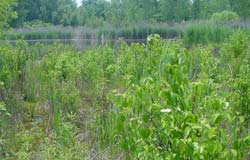The Greenbelt Native Plant Center (GNPC), a facility of the New York City Department of Parks & Recreation, is a 13–acre greenhouse, nursery, and seed bank complex located on Staten Island, NY.

Mission
Our mission is to provide native plants and seeds from local plant populations in support of the restoration and management of many of the City's most valuable natural areas.
Together with our colleagues in Parks and our partners throughout the region—
local conservation, research, education, botanic, and cultural institutions—we work towards the long–term sustainability of our natural resources through programming and research to improve the conservation value of the City's parkland.
Science–based Native Plant Production
Conserving Local Populations and Their Adaptations

Restoration of degraded land requires a science-based approach. Use of plant materials from local populations ensures the success of ecological restoration or enhancement of natural systems. Our seed collection begins by employing internationally accepted protocols for collecting seeds from wild populations that capture the full genetic variability of a given plant population. Genetic variation is the basis for evolutionary success.
Population biologists view species as consisting of discrete local populations which have, through evolution, acquired environmental adaptations now expressed as distinct ecotypes of that species. Rather than regard species as simply taxonomic units with a given distributional range, we recognize the taxonomic species as an aggregate of localized populations of that species—an approach that values local populations and their adaptations as an important resource to be conserved and protected.
Our nursery management is guided by principles of plant population conservation.
We research appropriate populations for seed harvest; collect seeds conservatively, so as to maintain extant populations; and record the provenance of each plant. With the aid of a custom–designed inventory database, we track each plant from seed source to project destination.
Only plants from locally collected seed can maintain the integrity of local populations.
The introduction of non–local ecotypes may weaken local populations through interbreeding. In addition, the relationship between plants, their pollinators, and seed dispersers warrants the use of local ecotypes to insure that these essential functions are not disrupted.
Our plants provide the greatest assurance of short–term establishment, long–term persistence, and ecological integration, and provide the most economically sound approach to restoration efforts.
Local ecotypes that have evolved with local climatic, edaphic (soil), and environmental conditions are best adapted to those conditions and are most resistant to disease and insect attack.
Related Information
Watch an It’s My Park Video on GNPC